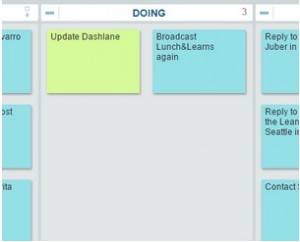In this interview, Toni and I got to interview two long time Personal Kanban users, Meghana and Sameer Bendre from Atlanta, Georgia. They mixed home and professional use - using PK to manage recovery from surgery, calming nerves in the house, visits from parents, and siblings with learning challenges. Of course, they also used PK at work managing teams and projects.
Dealing with Cans of Worms
We are all cursed with "surprises" at work. We come in, sit down, get ready for the day. We select a task to start on and about half way through, it explodes on us. The seemingly simple task now has 30 subtasks all lined up, ready to destroy our day.This is stressful. Since we're likely already overloaded, this new surprise just adds more work to the day and delay to our backlog.However, if we've limited our work-in-progress we look at these "cans of worms" a little differently. They still might be annoying, but they aren't quite so stressful. We understand that, like it or not, the amount of work necessary to get this task done has increased and we can adjust. The slack we've created in our schedule and our work by limiting WIP allows us to adjust gracefully (you can still gripe, it's okay) and plow through the extra work.
Five Years of Personal Kanban | Travel, Exploration, and Learning
It's been 5 wonderful years since Tonianne and I released the Personal Kanban book.The people we've met, the problems we've helped solve, the boards we've seen have been amazing. Every problem we've seen has had unique bits and predictable bits. What's been fun is learning what are those really predictable parts, what parts seem predictable, and what is novel.We've learned a lot since we started Modus Cooperandi and since we launched the book. Why we make certain decisions, why we focus on some things and not others, why we are so easily distracted, what systems actually help us create quality work and finish.This year we've launched a new webinar series and an online Personal Kanban class that extends what was in the book. Why an online class and not another book? Because we've found that human contact and short bursts of information mean a lot when adults are learning.We hope to see you there and thank you for five years of Personal Kanban awesome!
Complete Meaningful Tasks
The MusingOur work should provide value to someone or something, otherwise why do it?When we build our Personal Kanban, we are building a board that drives us toward completing our work. But is that work worth doing?val·uenoun
the regard that something is held to deserve; the importance, worth, or usefulness of something.
person's principles or standards of behavior; one's judgment of what is important in life.
verb
estimate the monetary worth of (something).
consider (someone or something) to be important or beneficial; have a high opinion of.
The words we use to describe value (regard, importance, usefulness, standards, beneficial) indicate that value is not merely based on cash, but also on how it makes us feel, how we respond to it. So when we say we want to understand the value of our work it means a great deal to us, to our colleagues, to our companies, and to society. You figure out in your own Ayn Rand to Che Guevara scale where your own value equilibrium lies.But … understand it and work towards it.The Practical ApplicationLet’s take a look at a simple case to see what this means practically.Over the Christmas break I quickly assessed how secure my internet holdings were. The answer was rather frightening. I, like most people, was extremely susceptible to hackers getting ahold of emails and passwords and running amok with my accounts.I downloaded Dashlane and began working with it to set strong and constantly changing passwords for all my accounts.My first ticket read “Update Dashlane”. I knew what Dashlane was and why I was updating it, so that seemed to make sense and tell me why I was doing the work.The problem: I had no idea what updating Dashlane meant to me. I knew I wanted to get done by the end of the week, but updating all your passwords and making sure you are letting others impacted by those changes know what’s changed leaves “Update Dashlane” as an open ended task.
I need a Victory Condition.So I created this ticket. “Update five sites in Dashlane.” Okay, great. That had a clear victory condition.The problem: I had no idea what I was working toward or where I was in the process. Or what I was working toward. What was my goal? I wanted to be more secure. Dashlane gives me a metric about security.I wanted to become more secure, not just update sites. Who cares if I update 100 sites and am still dismally unsecure?So, I changed the ticket yet again. This time to give myself a specific goal that was measured by Dashlane. I want to get to 80% by Friday. So 50% today, 60% tomorrow, 70% Thursday and 80% Friday. Four tickets, clear goal, all with demonstrated value.This was today’s card, it’s surrounded by other “Dones” which say what I am doing and the value provided. Note the card next to the 50% card tells me not just to reply to my colleague in Oregon, but also what resolution to get out of that reply.Sage AdviceWhen you create a card, ask yourself what the goal or the value of that work is. That not only gives you the task to complete, but the way to know when you have completed it. Quality and value are hard to determine without a definition. Let yourself know when you’ve achieved victory.And do yourself a favor … if you can’t come up with a goal or a value statement for your work, strongly question why you are doing it in the first place.
Text a Task Card to Your Kanban in LeanKit using Twilio and Zapier
First, you’ll need an account with Twilio, a popular programmable voice and SMS Service. Go to Twilio.com, and sign up for a new, free account.After you create your account, you’ll be asked for your phone number, and Twilio will send you a text message with a confirmation code, which you’ll need to enter on the next screen:Twilio will then generate a new phone number for your account:Now, open up Zapier.com, and log into your account, and create a new Zap, as shown below:Zapier will ask you to configure your Twilio account, using your Account SID and Auth Token from Twilio, shown below:Once you have set up your Twilio and LeanKit accounts correctly, you’ll see this:Select your Twilio number that you’ll send SMS messages to…And select the LeanKit board, lane, and card type. In the LeanKit “Title” (card title) field, choose “Body” from the list of available Twilio fields.Fill in the other required LeanKit fields:And finally, test and name your new Zap.You should now be able to text message your Twilio number (I created a contact in my iPhone for “LeanKit Twilio”, and a new LeanKit card will be created: This is the fifth post in the series by Chris Hefley of LeanKit showing how to integrate tools many of us use everyday with our Personal Kanban. You can read the previous post – Integrating Your Personal Kanban with Campfire in LeanKit using Zapier here.



















